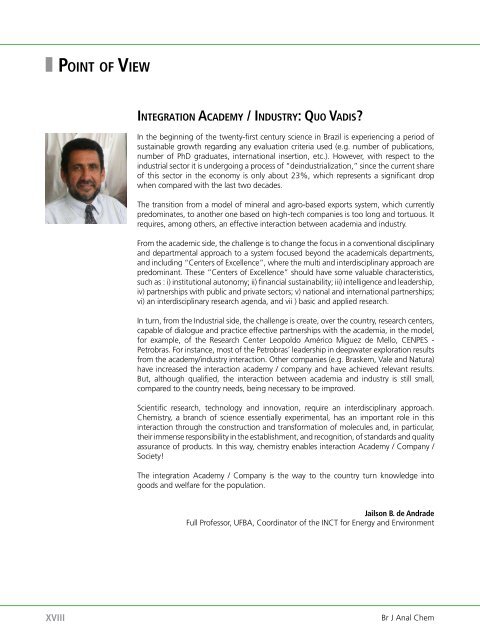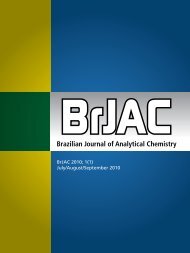Brazilian Journal of Analytical Chemistry - BRJAC - Brazilian Journal ...
Brazilian Journal of Analytical Chemistry - BRJAC - Brazilian Journal ...
Brazilian Journal of Analytical Chemistry - BRJAC - Brazilian Journal ...
You also want an ePaper? Increase the reach of your titles
YUMPU automatically turns print PDFs into web optimized ePapers that Google loves.
Po i n t o f viEw<br />
in t E g ra t i o n aC a d E m y / in d u s t r y: quo va d i s?<br />
In the beginning <strong>of</strong> the twenty-first century science in Brazil is experiencing a period <strong>of</strong><br />
sustainable growth regarding any evaluation criteria used (e.g. number <strong>of</strong> publications,<br />
number <strong>of</strong> PhD graduates, international insertion, etc.). However, with respect to the<br />
industrial sector it is undergoing a process <strong>of</strong> “deindustrialization,” since the current share<br />
<strong>of</strong> this sector in the economy is only about 23%, which represents a significant drop<br />
when compared with the last two decades.<br />
The transition from a model <strong>of</strong> mineral and agro-based exports system, which currently<br />
predominates, to another one based on high-tech companies is too long and tortuous. It<br />
requires, among others, an effective interaction between academia and industry.<br />
From the academic side, the challenge is to change the focus in a conventional disciplinary<br />
and departmental approach to a system focused beyond the academicals departments,<br />
and including “Centers <strong>of</strong> Excellence”, where the multi and interdisciplinary approach are<br />
predominant. These “Centers <strong>of</strong> Excellence” should have some valuable characteristics,<br />
such as : i) institutional autonomy; ii) financial sustainability; iii) intelligence and leadership,<br />
iv) partnerships with public and private sectors; v) national and international partnerships;<br />
vi) an interdisciplinary research agenda, and vii ) basic and applied research.<br />
In turn, from the Industrial side, the challenge is create, over the country, research centers,<br />
capable <strong>of</strong> dialogue and practice effective partnerships with the academia, in the model,<br />
for example, <strong>of</strong> the Research Center Leopoldo Américo Miguez de Mello, CENPES -<br />
Petrobras. For instance, most <strong>of</strong> the Petrobras’ leadership in deepwater exploration results<br />
from the academy/industry interaction. Other companies (e.g. Braskem, Vale and Natura)<br />
have increased the interaction academy / company and have achieved relevant results.<br />
But, although qualified, the interaction between academia and industry is still small,<br />
compared to the country needs, being necessary to be improved.<br />
Scientific research, technology and innovation, require an interdisciplinary approach.<br />
<strong>Chemistry</strong>, a branch <strong>of</strong> science essentially experimental, has an important role in this<br />
interaction through the construction and transformation <strong>of</strong> molecules and, in particular,<br />
their immense responsibility in the establishment, and recognition, <strong>of</strong> standards and quality<br />
assurance <strong>of</strong> products. In this way, chemistry enables interaction Academy / Company /<br />
Society!<br />
The integration Academy / Company is the way to the country turn knowledge into<br />
goods and welfare for the population.<br />
Jailson B. de Andrade<br />
Full Pr<strong>of</strong>essor, UFBA, Coordinator <strong>of</strong> the INCT for Energy and Environment<br />
XVIII Br J Anal Chem



